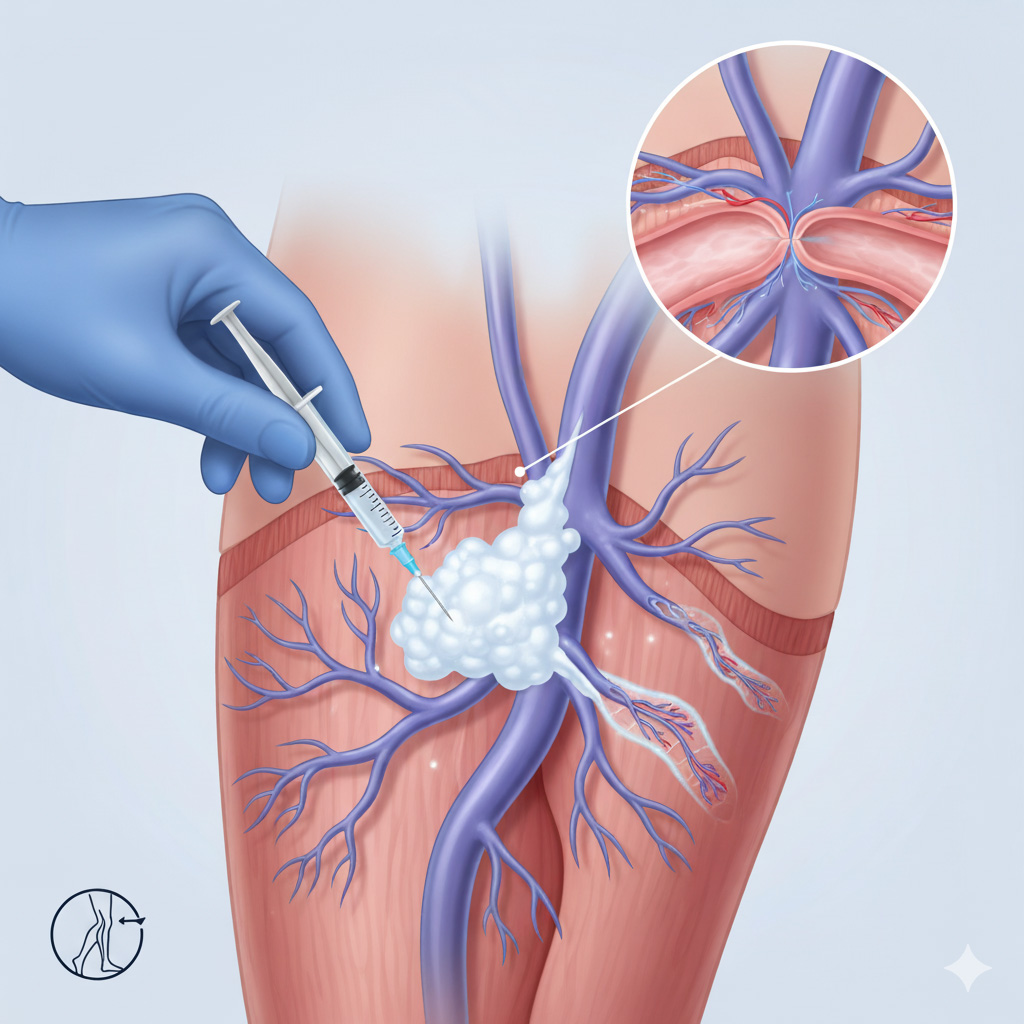Varicose veins are not just a physical condition—they also impact aesthetics and mental well-being, significantly lowering the quality of life. Spider veins, in particular, become more visible during the summer months, making many people uncomfortable with their appearance. Fortunately, Visual Foam Sclerotherapy (V.F.S.), a modern, non-surgical treatment, offers a practical and effective solution. Visual foam sclerotherapy is one of the most advanced techniques for treating spider veins. The method involves injecting a specialized medication mixed with carbon dioxide and oxygen in foam form into the problematic vein using very fine needles. This foam causes the vein walls to shrink and close, and the body eventually absorbs the vein. In addition to aesthetic improvements, symptoms such as pain, burning, and nighttime leg cramps often disappear. The procedure has shown success in approximately 80% of patients.
Which Veins Are Suitable for Visual Foam Sclerotherapy?
Visual Foam Sclerotherapy is particularly effective for the following types of veins:
- Spider Veins (1–3 mm): Thin red or blue veins close to the surface of the skin.
- Reticular Veins (3–4 mm): Slightly larger, greenish or bluish veins typically found deeper under the skin.
Spider and reticular veins are extremely common, affecting 80% of women and 50% of men over the age of 21. Without treatment, they often increase in size and number, and attempts to hide them with makeup or sun exposure become ineffective over time. Early intervention provides both aesthetic and clinical advantages.
Visual Foam Sclerotherapy is not limited to the legs—it can also be used to treat visible capillaries on the face, neck, hands, wrists, and arms.

How Is the Procedure Performed? Step-by-Step Process
- Doppler Ultrasound Evaluation – The underlying vein structure is assessed before treatment.
- Light and Magnification – Special light and magnifying lenses help identify the affected veins.
- Foam Injection via Fine Needle – The foam solution is injected precisely into the vein.
- Pressure Band Application – Treated areas are supported with specialized adhesive compression bands.
- Compression Stockings – Patients wear compression stockings and can resume daily activities immediately.
The entire procedure takes about 60 to 90 minutes, does not require anesthesia, and is performed in a clinical setting. Patients can walk out of the clinic the same day.
Watch Prof. Dr. Semih Barlas’ Video
Post-Treatment Care: What Should You Watch Out For?
- Avoid showering on the first day.
- Keep treated areas protected from sun exposure.
- Apply high-SPF sunscreen when necessary.
- Use prescribed creams to reduce bruising or skin discoloration.
- Stay hydrated and engage in light walking to promote healing.
- Monitor your legs for new veins and schedule check-ups if needed.
It’s important to note that eliminating existing veins does not prevent new veins from forming. That’s why regular follow-ups are highly recommended.
Benefits of Visual Foam Sclerotherapy
- No need for surgical incisions or stitches
- Leaves no visible scars or marks
- Performed without general anesthesia
- Patients can return home the same day
- Fast recovery and return to daily life
- Pain-free and comfortable process
- Up to 80% success rate
Potential Side Effects and Risks
Visual foam sclerotherapy is generally considered safe. However, some patients may experience mild side effects such as:
- Itching (1–4 days)
- Mild bruising or swelling
- Hyperpigmentation – light brown lines/spots in 10% of cases, usually temporary
- Pain – may last 1–7 days, ice application recommended
- Skin peeling – seen in fewer than 1% of patients
- Allergic reactions – rare, more common in patients with allergy history
- Matting – appearance of fine red veins after treatment, may last 4–6 months
- Ankle swelling – usually resolves in a few days with compression
- Phlebitis – occurs in 0.1% of cases with larger veins
- Transient migraine or blurred vision – rare in those with an undiagnosed heart defect
All side effects are usually temporary and can be minimized with proper technique and post-treatment care.
Who Should Not Have Visual Foam Sclerotherapy?
This treatment is not recommended for individuals with the following conditions:
- Pregnancy or breastfeeding
- Bloodborne infectious diseases
- Uncontrolled diabetes or advanced heart disease
- Blood clotting disorders
- Unclosed congenital heart defects

Frequently Asked Questions
Does the treatment hurt?
No. The procedure is nearly painless, thanks to ultra-fine needles.
How many sessions are needed?
It varies based on the vein’s extent. Typically, 1 to 3 sessions are sufficient.
When will I see results?
Full results usually appear within 3 weeks to 2 months.
Can new veins appear later?
Yes, in different areas. Routine follow-up is advised.
Can the treatment be done in summer?
Absolutely. It’s safe with sun protection and proper aftercare.
Conclusion: Aesthetic and Health Benefits Combined
Visual foam sclerotherapy is a state-of-the-art, effective, and non-invasive option for treating spider veins. Its non-surgical nature, fast recovery, and minimal disruption to daily life have made it a top choice for modern varicose vein treatment.
Don’t wait to address your vein concerns. Take a step toward smoother, healthier legs today.
🔗 Internal Links
Prof. Dr. Semih Barlas official web site
More about Visual Foam Sclerotherapy (V.F.S.)
🌐 External Links
Modern Treatment Methods Video

